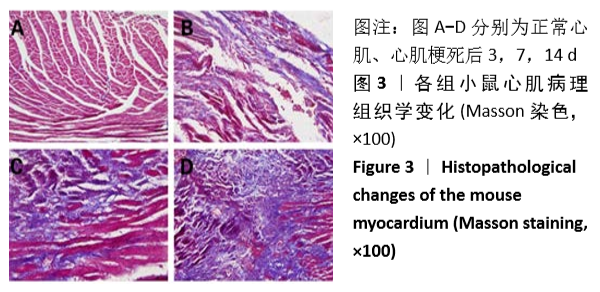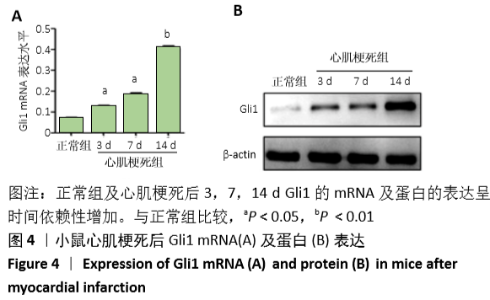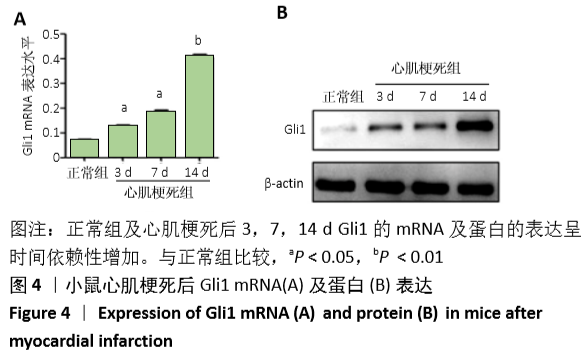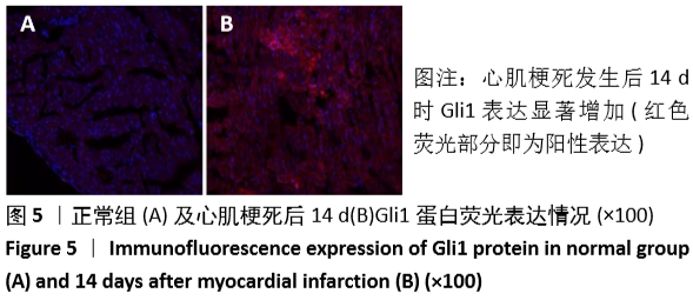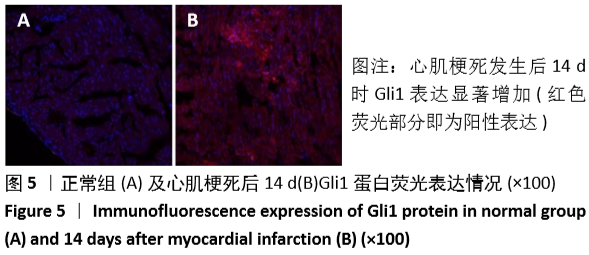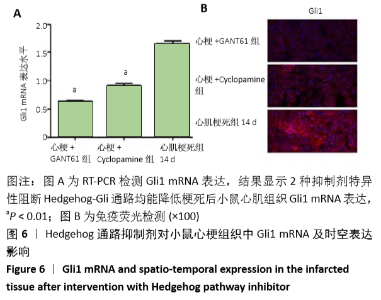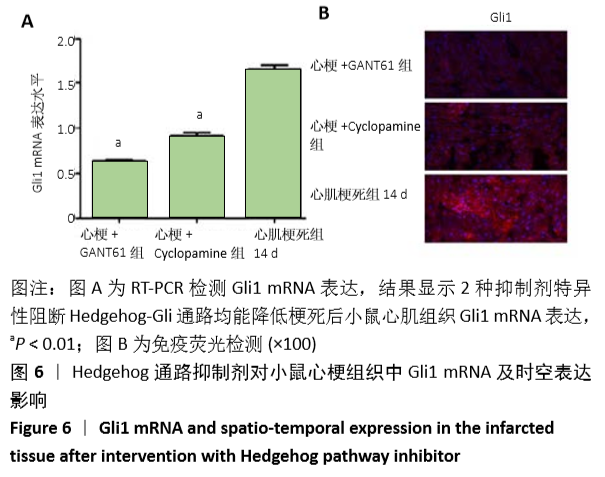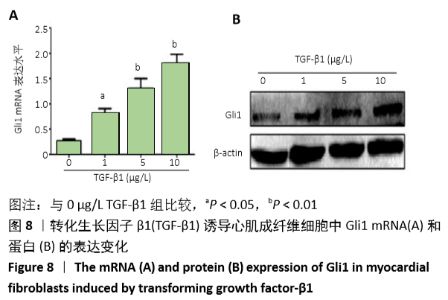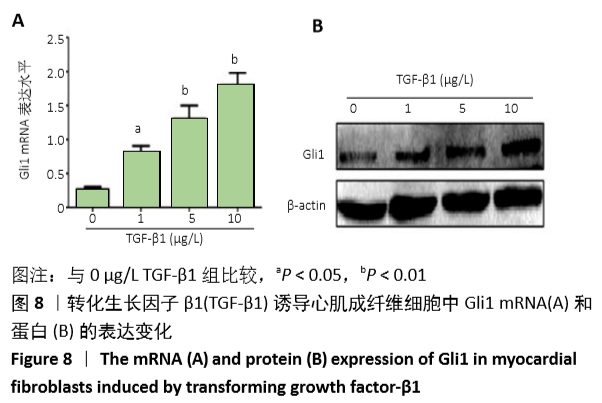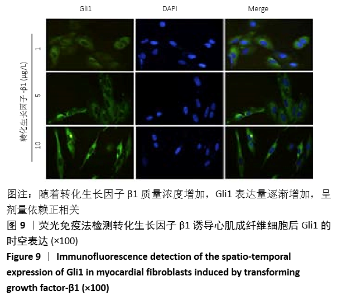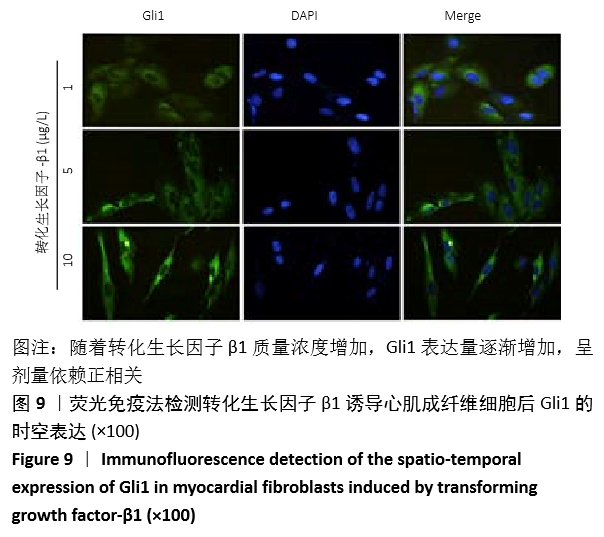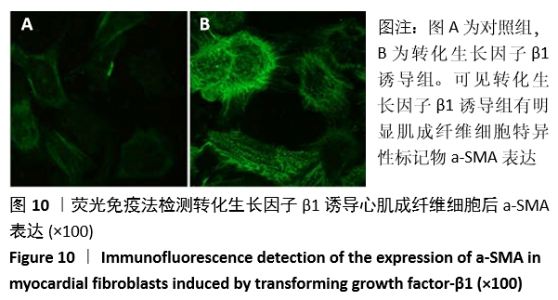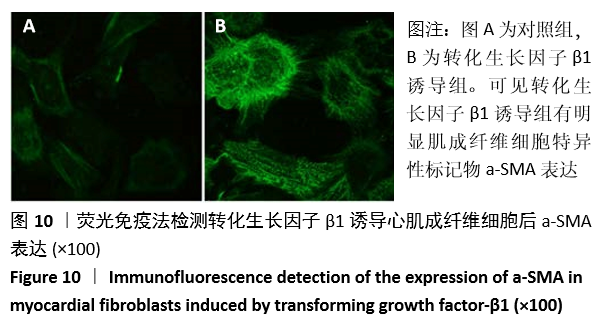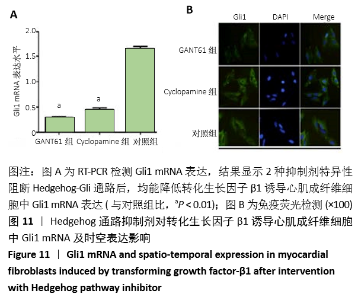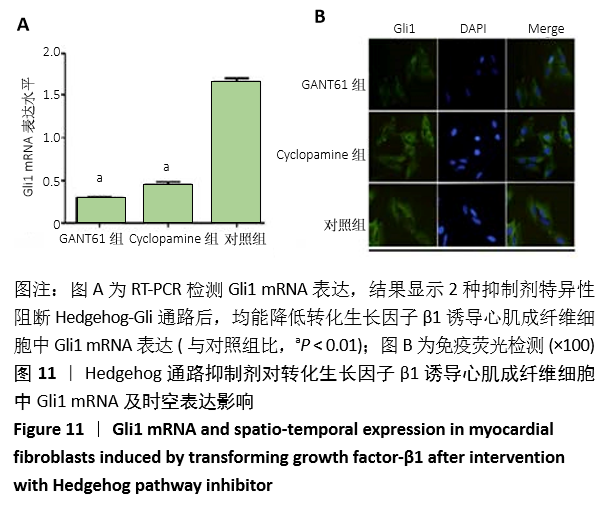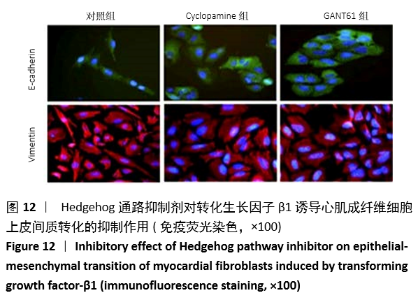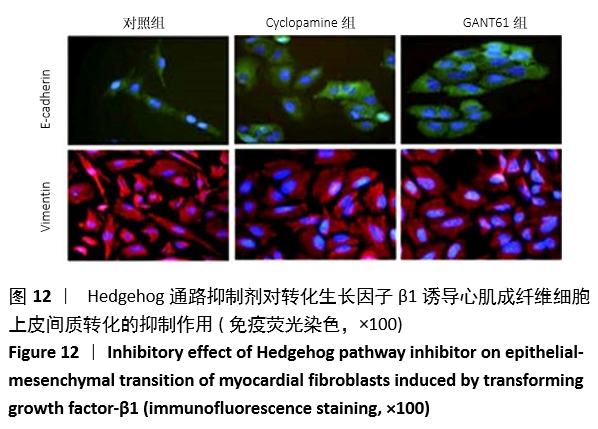Chinese Journal of Tissue Engineering Research ›› 2021, Vol. 25 ›› Issue (5): 754-760.doi: 10.3969/j.issn.2095-4344.3011
Previous Articles Next Articles
The role of Hedgehog signaling pathway in transforming growth factor beta1-induced myofibroblast transdifferentiation
Nie Huijuan, Huang Zhichun
- Department of Cardiology, Affiliated Hospital of Inner Mongolia Medical University, Hohhot 010059, Inner Mongolia Autonomous Region, China
-
Received:2020-05-19Revised:2020-05-21Accepted:2020-06-12Online:2021-02-18Published:2020-12-01 -
Contact:Huang Zhichun, MD, Chief physician, Professor, Department of Cardiology, Affiliated Hospital of Inner Mongolia Medical University, Hohhot 010059, Inner Mongolia Autonomous Region, China -
About author:Nie Huijuan, MD, Associate chief physician, Associate professor, Department of Cardiology, Affiliated Hospital of Inner Mongolia Medical University, Hohhot 010059, Inner Mongolia Autonomous Region, China -
Supported by:the Natural Science Foundation of Inner Mongolia Autonomous Region (General Project), No. 2016MS(LH)0802
CLC Number:
Cite this article
Nie Huijuan, Huang Zhichun. The role of Hedgehog signaling pathway in transforming growth factor beta1-induced myofibroblast transdifferentiation[J]. Chinese Journal of Tissue Engineering Research, 2021, 25(5): 754-760.
share this article
Add to citation manager EndNote|Reference Manager|ProCite|BibTeX|RefWorks
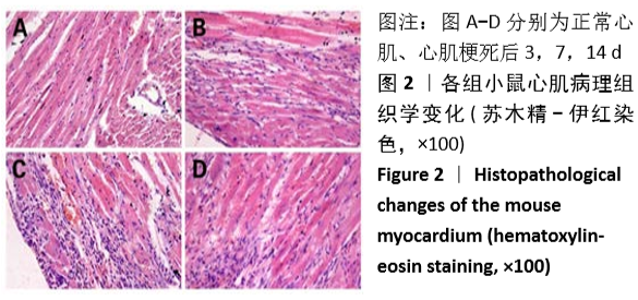
2.1 动物实验结果 2.1.1 建模成功率 小鼠共计40只,建模成功25只,建模成功率为62.5%。分析小鼠主要死亡原因为:感染、肺损伤及麻醉复苏不成功等。 2.1.2 心肌梗死后心肌纤维化病理变化观察 小鼠经左冠状动脉前降支结扎术,术后可见结扎的损伤区域心肌收缩幅度明显减弱,颜色变苍白紫绀缺氧状态,待术后取标本时发现心肌梗死区域心肌组织被纤维瘢痕组织所代替。心肌病理学染色可见:心肌纤维红染,胶原纤维蓝染,心肌梗死发生后心肌细胞排列逐渐紊乱,炎症细胞浸润,心肌纤维断裂,纤维化形成,随着时间延长,纤维化逐渐加重。小鼠心梗组织切片经苏木精-伊红染色处理后,光学显微镜下观察切片。可见结扎区域梗死部位心肌坏死,少量心肌细胞存活,大量炎症细胞浸润,胶原纤维异常增生堆积,心肌纤维断裂,排列结构紊乱,见图2。"
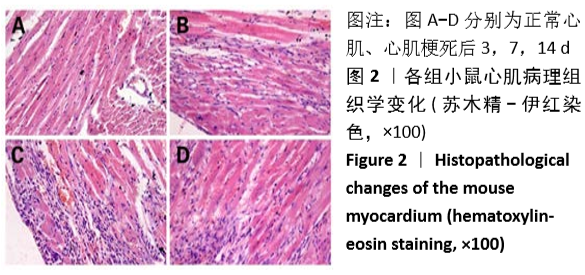
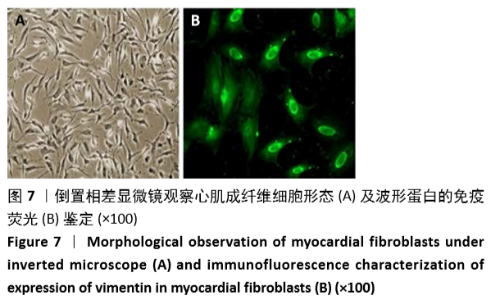
2.2 细胞实验结果 2.2.1 SD乳鼠心肌成纤维细胞鉴定 差速贴壁培养法培养60-90 min后,可见心肌成纤维细胞贴壁,倒置相差显微镜下观察新生SD乳鼠心肌成纤维细胞形态,多为不规则形,三角形或星形,一般含有两三个细胞核,核较大而且多居中,细胞核呈卵圆形,胞质透明(图7A)。随着细胞融合度的不断增加,逐渐变为梭形。波形蛋白Vimentin是存在于间质起源细胞中间丝的主要结构蛋白,是心肌成纤维细胞特异性生物学标记物,波形蛋白Vimentin呈阳性表达,证实培养的细胞为心肌成纤维细胞,图7B中绿色荧光部分即为阳性表达。 2.2.2 TGF-β1诱导心肌成纤维细胞Gli1呈高表达 心肌成纤维细胞在不同质量浓度的TGF-β1(0,1,5,10 μg/L)刺激作用下,通过RT-PCR、Western Blot、免疫荧光检测发现,TGF-β1刺激心肌成纤维细胞后Hedgehog信号通路的下游的因子Gli1的表达明显增加,证实了Gli1参与心肌纤维化发生发展的过程,且随着TGF-β1质量浓度增加,Gli1表达量逐渐增加,呈剂量依赖正相关,见图8,9。选择下面实验的最佳TGF-β1质量浓度为10 μg/L。"
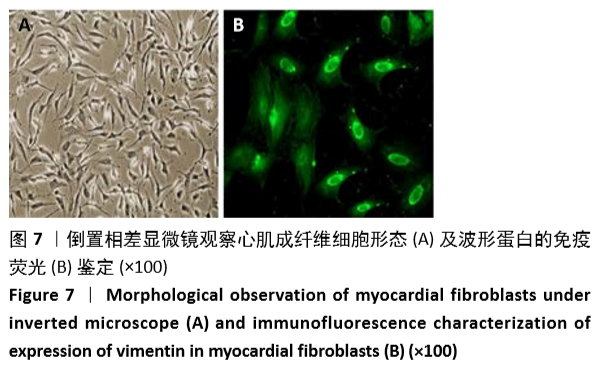
| [1] CHISTIAKOV DA, OREKHOV AN, BOBRYSHEV YV. The role of cardiac fibroblasts in post myocardial heart tissue repair.Exp Mol Pathol. 2016; 101(2):231-240. [2] STEMPIE OTERO A, KIM DH, DAVIS J. Molecular networks underlying myofibroblast fate and fibrosis.J Mol Cell Cardiol.2016;97(2):153-161. [3] KARAMITSOS TD, ARVANITAKI A, KARVOUNIS H, et al.Myocardial Tissue Characterization and Fibrosis by Imaging.JACC Cardiovasc Imaging. 2020;13(5):1221-1234. [4] TRAVERS JG, KAMAL FA, ROBBINS J, et al, Cardiac fibrosis: The fibroblast awakens. Circ Res. 2016;118(8):1021-1040. [5] MOORE MORRIS T, CATTANEO P, PUCEAT M, et al. Origins of cardiac fibroblasts. J Mol Cell Cardiol.2016;91(1):1-5. [6] CHAVES AT, MENEZES CAS, COSTA HS, et al. Myocardial fibrosis in chagas disease and molecules related to fibrosis. 2019;41(10):e12663. [7] THOMSON TM, BALCELLS C, CASCANTE M. Metabolic Plasticity and Epithelial-Mesenchymal Transition.J Clin Med.2019;8(7):967. [8] LORENZO-ALMOROS A, TUNON J, OREJAS M, et al. Diagnostic approaches for diabetic cardiomyopathy. Cardiovasc Diabetol.2017; 16(6)28-29. [9] ZHOU L, LIU JL, OLSON P, et al. Tbx5 and Osr1 interact to regulate posterior second heart field cell cycle progression for cardiac septation. J Mol Cell Cardiol.2015:85(3):1-12. [10] PERBELLINI F, WATSON SA, SCIGLIANO M, et al. Investigation of cardiac fibroblasts using myocardilices.Cardiovasc Res.2018;114(1):77-89. [11] ZHANG KK, XIANG ML, ZHOU L, et al. Gene network and familial analyses uncover a gene network involving Tbx5/Osr1/Pcsk6 interaction in the second heart field for atrial septation. Hum Mol Genet. 2016; 25(6):1140–1151. [12] COELHO LL, PEREIRA IR, DE SOUZA PEREIRA MC, et al. Trypanosoma cruzi activates mouse cardiac fibroblasts in vitro leading to fibroblast myofibroblast transition and increase inexpression of extracellular matrix proteins. Parasit Vectors. 2018;11(1):72. [13] TALLQUIST MD. Developmental Pathways of Cardiac Fibroblasts. Cold Spring Harb Perspect Biol. 2020;12(4):a037184. [14] AHMED-DE-PRADO S, DIAZ-GARCIA S, BAONZA A.JNK and JAK/STAT signalling are required for inducing loss of cell fate specification during imaginal wing discs regeneration in Drosophila melanogaster.Dev Biol. 2018;441(10):31-41. [15] Worley MI, Alexander LA, Hariharan IK.CtBP impedes JNK and Upd/STAT-driven cell fate misspecifications in regenerating Drosophila imaginal discs. Elife. 2018;7:e30391. [16] 李小群,高凌志,张进,等.高效建立成年小鼠心肌梗死模型[J].四川动物,2012,31(4):635-638 [17] HAN H, CHO JW, LEE S, et al. TRRUST v2: an expanded reference database of human and mouse transcriptional regulatory interactions. Nucleic Acids Res.2018;46(2):D380-D386. [18] Patterson M, Barske L, Van Handel B, et al. Frequency of mononuclear diploid cardiomyocytes underlies natural variation in heart regeneration. Nat Genet. 2017;49(8):1346-1353. [19] FOULQUIER S, DASKALOPOULOS EP, LLURI G, et al. WNT signaling in cardiac and vascular disease.Pharmacol Rev. 2018;70:68-141. [20] Herrera SC, Bach EA. JAK/STAT signaling in stem cells and regeneration:from Drosophila to vertebrates. Development. 2019; 146(2):dev167643. [21] ZHANG J,CUI Y, SUN S,et al.Casticin inhibits the epithelisa mesenchymal transition in ovarian carcinoma via the hedgehog signaling pathway. Oncol Lett. 2018;15(4):4495-4502. |
| [1] | Pu Rui, Chen Ziyang, Yuan Lingyan. Characteristics and effects of exosomes from different cell sources in cardioprotection [J]. Chinese Journal of Tissue Engineering Research, 2021, 25(在线): 1-. |
| [2] | Zhang Yu, Tian Shaoqi, Zeng Guobo, Hu Chuan. Risk factors for myocardial infarction following primary total joint arthroplasty [J]. Chinese Journal of Tissue Engineering Research, 2021, 25(9): 1340-1345. |
| [3] | Yuan Jiawei, Zhang Haitao, Jie Ke, Cao Houran, Zeng Yirong. Underlying targets and mechanism of Taohong Siwu Decoction in prosthetic joint infection on network pharmacology [J]. Chinese Journal of Tissue Engineering Research, 2021, 25(9): 1428-1433. |
| [4] | Gu Xia, Zhao Min, Wang Pingyi, Li Yimei, Li Wenhua. Relationship between hypoxia inducible factor 1 alpha and hypoxia signaling pathway [J]. Chinese Journal of Tissue Engineering Research, 2021, 25(8): 1284-1289. |
| [5] | Chai Le, Lü Jianlan, Hu Jintao, Hu Huahui, Xu Qingjun, Yu Jinwei, Quan Renfu. Signal pathway variation after induction of inflammatory response in rats with acute spinal cord injury [J]. Chinese Journal of Tissue Engineering Research, 2021, 25(8): 1218-1223. |
| [6] | Geng Qiudong, Ge Haiya, Wang Heming, Li Nan. Role and mechanism of Guilu Erxianjiao in treatment of osteoarthritis based on network pharmacology [J]. Chinese Journal of Tissue Engineering Research, 2021, 25(8): 1229-1236. |
| [7] | Li Zhongfeng, Chen Minghai, Fan Yinuo, Wei Qiushi, He Wei, Chen Zhenqiu. Mechanism of Yougui Yin for steroid-induced femoral head necrosis based on network pharmacology [J]. Chinese Journal of Tissue Engineering Research, 2021, 25(8): 1256-1263. |
| [8] | Liao Chengcheng, An Jiaxing, Tan Zhangxue, Wang Qian, Liu Jianguo. Therapeutic target and application prospects of oral squamous cell carcinoma stem cells [J]. Chinese Journal of Tissue Engineering Research, 2021, 25(7): 1096-1103. |
| [9] | Liang Xueqi, Guo Lijiao, Chen Hejie, Wu Jie, Sun Yaqi, Xing Zhikun, Zou Hailiang, Chen Xueling, Wu Xiangwei. Alveolar echinococcosis protoscolices inhibits the differentiation of bone marrow mesenchymal stem cells into fibroblasts [J]. Chinese Journal of Tissue Engineering Research, 2021, 25(7): 996-1001. |
| [10] | Geng Yao, Yin Zhiliang, Li Xingping, Xiao Dongqin, Hou Weiguang. Role of hsa-miRNA-223-3p in regulating osteogenic differentiation of human bone marrow mesenchymal stem cells [J]. Chinese Journal of Tissue Engineering Research, 2021, 25(7): 1008-1013. |
| [11] | Zhu Xuefen, Huang Cheng, Ding Jian, Dai Yongping, Liu Yuanbing, Le Lixiang, Wang Liangliang, Yang Jiandong. Mechanism of bone marrow mesenchymal stem cells differentiation into functional neurons induced by glial cell line derived neurotrophic factor [J]. Chinese Journal of Tissue Engineering Research, 2021, 25(7): 1019-1025. |
| [12] | Pei Lili, Sun Guicai, Wang Di. Salvianolic acid B inhibits oxidative damage of bone marrow mesenchymal stem cells and promotes differentiation into cardiomyocytes [J]. Chinese Journal of Tissue Engineering Research, 2021, 25(7): 1032-1036. |
| [13] | Wang Hanyue, Li Furong, Yang Xiaofei, Hu Chaofeng. Direct reprogramming hepatocytes into islet-like cells by efficiently targeting and activating the endogenous genes [J]. Chinese Journal of Tissue Engineering Research, 2021, 25(7): 1056-1063. |
| [14] | Li Shibin, Lai Yu, Zhou Yi, Liao Jianzhao, Zhang Xiaoyun, Zhang Xuan. Pathogenesis of hormonal osteonecrosis of the femoral head and the target effect of related signaling pathways [J]. Chinese Journal of Tissue Engineering Research, 2021, 25(6): 935-941. |
| [15] | Liu Xin, Yan Feihua, Hong Kunhao. Delaying cartilage degeneration by regulating the expression of aquaporins in rats with knee osteoarthritis [J]. Chinese Journal of Tissue Engineering Research, 2021, 25(5): 668-673. |
| Viewed | ||||||
|
Full text |
|
|||||
|
Abstract |
|
|||||

